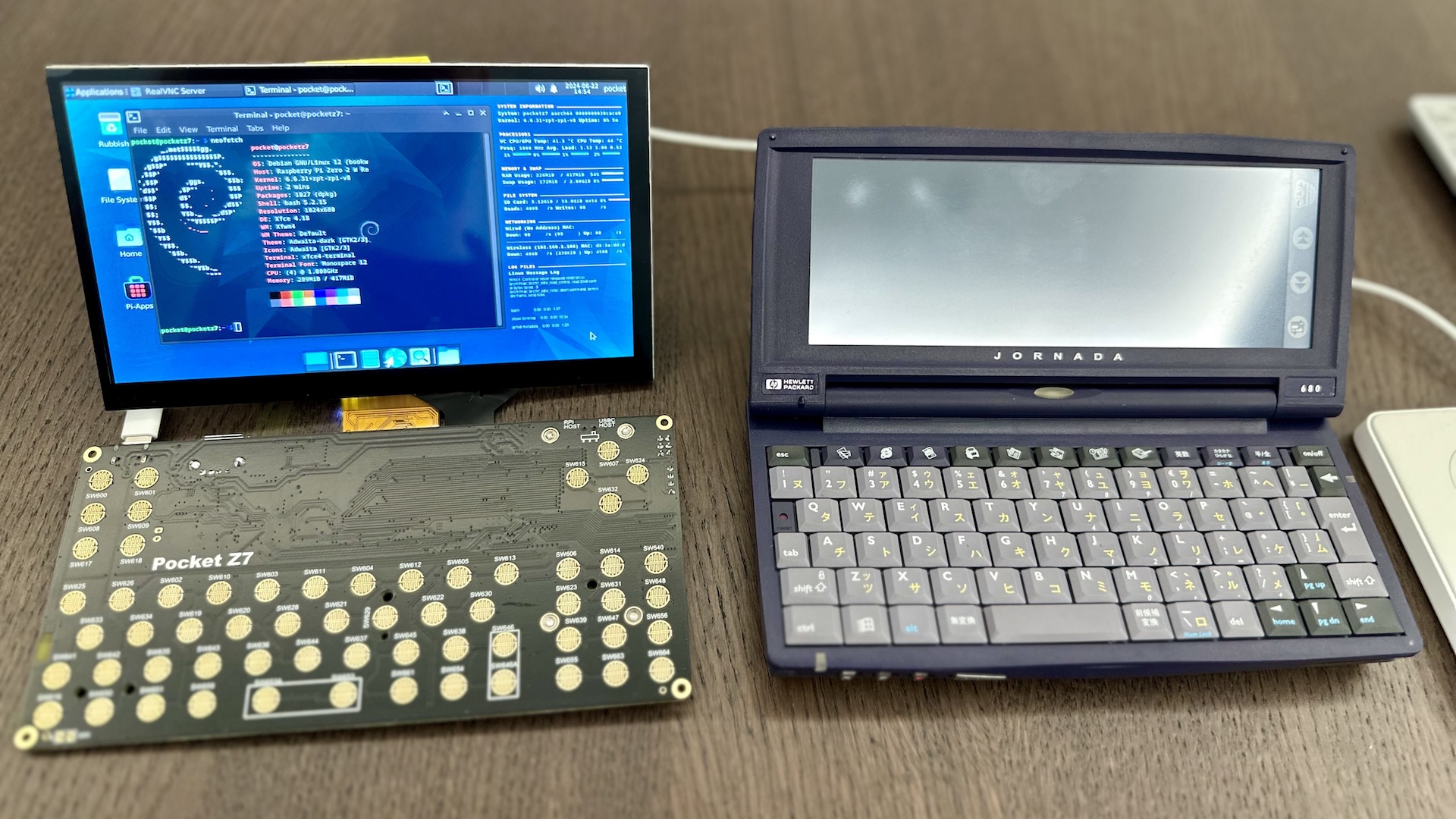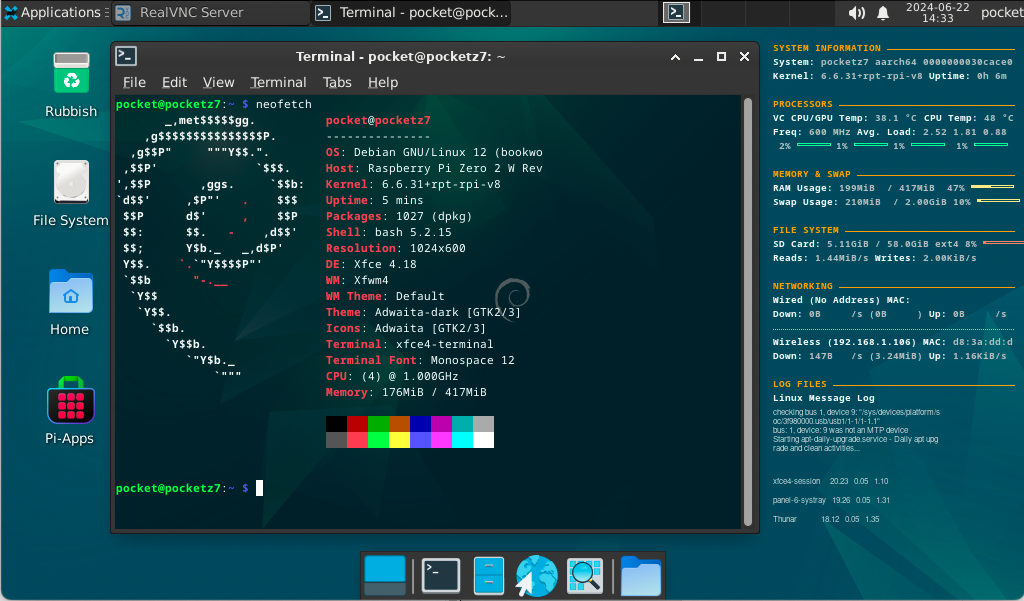Pocket Z project hopes to rekindle pocket PC form factor — with a Raspberry Pi Zero 2W inside

Today’s mobile computing space is dominated by smartphones, tablets, and laptop computers. One maker remembers the no-standards frontier days of mobile computers, though. Harkening back to the PalmPilot, Apple Newton, and ultra-mobile PCs (UPMCs) like the HP Jornada 720, the creator is developing the Raspberry Pi-powered Pocket Z into a UPMC for under $100.
The software engineer known as Icepat on Hackaday has a first prototype already in hand. This UPMC has a seven-inch 1024 x 600-pixel capacitive touchscreen display, and a silicone membrane keyboard, and runs Linux. Since the goal is to have a GUI, the Pocket Z runs the XFCE Desktop Environment and Conky. It’s all driven by a Raspberry Pi Zero 2 W.
To keep the cost down, Icepat connected the touchscreen display to the Pi Zero 2 W using the board’s GPIO headers. One perhaps negative effect of this is that the display uses all of the development board’s GPIO pins. There’s nothing left for sensors or additional accessories for hacking purposes.
The UPMC has a USB-C connector for the power management system and a lithium-polymer (Li-Po) battery. Icepat also added a single USB-A port for connecting accessories like a mouse, keyboard, or external storage. The Pocket Z also has its own keyboard, controlled by an Atmega32U4 microcontroller with a TI-92 keyboard layout.
Icepat was able to get the first prototype to boot into Raspberry Pi OS Lite and load the XFCE desktop environment and learned some important lessons along the way. The hope is to bring the display down to a 5-inch version, similar to a Sharp Zaurus.
Icepat also says it would be nice to develop a custom keyboard for the UPMC, but acknowledges that “Building a good keyboard is really hard and a low price point is still one of the main goals.” The project is off to a good start, though. It will be interesting to see what comes of it.
Get Tom's Hardware's best news and in-depth reviews, straight to your inbox.

Jeff Butts has been covering tech news for more than a decade, and his IT experience predates the internet. Yes, he remembers when 9600 baud was “fast.” He especially enjoys covering DIY and Maker topics, along with anything on the bleeding edge of technology.
-
LabRat 891 Kinda feel like the R Pi mod space is over-saturated. NtM, lacking x86 leaves this concept 'kneecapped' out the gate.Reply
Throw in an ultra-low TDP AMD APU or Intel chip, then maybe it'd be interesting. -
usertests Reply
There's certainly a lot of Alder Lake-N chips to go around, and they can run fanless, leaving a lot of performance on the table of course.LabRat 891 said:Kinda feel like the R Pi mod space is over-saturated. NtM, lacking x86 leaves this concept 'kneecapped' out the gate.
Throw in an ultra-low TDP AMD APU or Intel chip, then maybe it'd be interesting.
AMD's Mendocino is competitive with Alder Lake-N but is rare on the market. AMD clearly doesn't care to make enough of them.
Pi Zero 2W is a big improvement on the original with one glaring exception: the RAM, still stuck at 512 MB. 1 GB would have been much better, and at 2 GB it would be sufficient for many use cases. -
Notton I read the selling pitch page, and I'm not convinced this could be made for under $100.Reply
The <$100 category is filled with cheap android smartphones that barely run android 11/12/13, or amazon's fire 7 tablet.
Once you get into the $180~$250 range, the smartphones and tablets become decent enough to run newer android versions smoothly.
The above prices don't include a keyboard cover or regular BT keyboard with stand.
For the 7" UMPC category, there is already the GPD win mini, but it has high end specs, so maybe they can bring the costs down by using a raspi or some other cheap soc.
These are oddly strict requirements, when all of the hardware for the cheap sub 10" screen device is purely android, and raspi itself can run android. I thought the main hurdle to this approach was lack of hardware documentation.
It has to be a true Linux computer and not just an other Android Smartphone (Gemini/Cosmo from Plant Computer, PinePhone, Astro Slide...)
It needs to be powerful enough to run a Linux Desktop environment (while there is no need for it to be comparable to a smartphone level of performances)
Best of luck to the creator. -
GoofyOne You can play 'what if' for a long time ... what if you used this or that or ...Reply
The important thing is that someone is using their grey cells to create something. People making things with the Pi Zero and Pico Pi are awesome. :cool:
{GoofyOne's 2c worth, which may or may not be actually worth 2c} -
Icepat Reply
Creator here : the goal of this project is not to compete with currently available laptops but bring back low cost PDA/UMPC. There is 7" x86 laptops available for like 250$ on Aliexpress already.LabRat 891 said:Kinda feel like the R Pi mod space is over-saturated. NtM, lacking x86 leaves this concept 'kneecapped' out the gate.
Throw in an ultra-low TDP AMD APU or Intel chip, then maybe it'd be interesting.
We are trying to get it to 99$ total (without the Pi) and while it will not be an easy task I believe it is indeed possible if we build 1000 of them. Currently the display cost like 15$ and the board itself cost 100$ with assembly but we only built 3. So we should be able to bring the board down to 20$ I think, then the keyboard and case woulc also be costly because we need to create an injection mould for each.Notton said:I read the selling pitch page, and I'm not convinced this could be made for under $100.
The <$100 category is filled with cheap android smartphones that barely run android 11/12/13, or amazon's fire 7 tablet.
Once you get into the $180~$250 range, the smartphones and tablets become decent enough to run newer android versions smoothly.
The above prices don't include a keyboard cover or regular BT keyboard with stand.
For the 7" UMPC category, there is already the GPD win mini, but it has high end specs, so maybe they can bring the costs down by using a raspi or some other cheap soc.
These are oddly strict requirements, when all of the hardware for the cheap sub 10" screen device is purely android, and raspi itself can run android. I thought the main hurdle to this approach was lack of hardware documentation.
Best of luck to the creator.
So if we can make it for 99$ it still has it's own little market I believe, for a cheap portable Linux terminal. There is no need for Android as there is plenty of Android devices available out there, the goal is to have a pocketable Linux computer.
The Raspberry Pis can run Android yes but we are using a Pi Zero 2W here which is the weakest of the Pi product available now (but also the cheapest), running Android on this one will not be a very enjoyable experience.
Thanks ! Please share your feedback as we want to build it for the community so we are open to suggestions & ideas !GoofyOne said:You can play 'what if' for a long time ... what if you used this or that or ...
The important thing is that someone is using their grey cells to create something. People making things with the Pi Zero and Pico Pi are awesome. :cool:
{GoofyOne's 2c worth, which may or may not be actually worth 2c} -
das_stig As a geriatric old school field engineer, something as small as this dual booting Linux/Windows for diagnostic/manuals would have been great rather than lumping around a laptop, especially if it came with a micro hdmi port to hook a monitor up when onsiteReply -
Icepat Reply
That's one of the goal yes.das_stig said:As a geriatric old school field engineer, something as small as this dual booting Linux/Windows for diagnostic/manuals would have been great rather than lumping around a laptop, especially if it came with a micro hdmi port to hook a monitor up when onsite -
TheJoker2020 Reply
AMD is selling them as fast as they can be made by TSMC.usertests said:AMD clearly doesn't care to make enough of them. -
usertests Reply
Alder Lake-N is ubiquitous on the market, Mendocino is a unicorn. AMD has a number of other things they can make on N6.TheJoker2020 said:AMD is selling them as fast as they can be made by TSMC.


